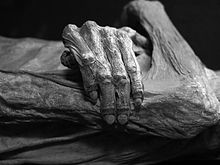- Death
-
"Dying" redirects here. For the process of coloring, see Dyeing. For other uses, see Near-death (disambiguation).
Death is the permanent termination of the biological functions that sustain a living organism. Phenomena which commonly bring about death include old age, predation, malnutrition, disease, and accidents or trauma resulting in terminal injury.
The nature of death has been for millennia a central concern of the world's religious traditions and of philosophical enquiry, and belief in some kind of afterlife or rebirth has been a central aspect of religious faith.
Contents
Etymology
The word death comes from Old English deað, which in turn comes from Proto-Germanic *dauþaz (reconstructed by etymological analysis). This comes from the Proto-Indo-European stem *dheu- meaning the 'Process, act, condition of dying'.
Senescence
Almost all animals who survive external hazards to their biological functioning eventually die from senescence. One of the few known exceptions is the jellyfish Turritopsis nutricula, thought to be, in effect, immortal.[1] Causes of death in humans as a result of intentional activity include suicide and homicide. From all causes, roughly 150,000 people die around the world each day.[2]
Physiological death is now seen as a process, more than an event: conditions once considered indicative of death are now reversible.[3] Where in the process a dividing line is drawn between life and death depends on factors beyond the presence or absence of vital signs. In general, clinical death is neither necessary nor sufficient for a determination of legal death. A patient with working heart and lungs determined to be brain dead can be pronounced legally dead without clinical death occurring. Precise medical definition of death, in other words, becomes more problematic, paradoxically, as scientific knowledge and medicine advance.[4]
Symptoms of death
Signs of death or strong indications that an animal is no longer alive are:
- Cessation of breathing
- Cardiac arrest (No pulse)
- Pallor mortis, paleness which happens in the 15–120 minutes after death
- Livor mortis, a settling of the blood in the lower (dependent) portion of the body
- Algor mortis, the reduction in body temperature following death. This is generally a steady decline until matching ambient temperature
- Rigor mortis, the limbs of the corpse become stiff (Latin rigor) and difficult to move or manipulate
- Decomposition, the reduction into simpler forms of matter, accompanied by a strong, unpleasant odor.
Diagnosis
Problems of definition
 A flower, a skull and an hourglass stand in for Life, Death and Time in this 17th-century painting by Philippe de Champaigne
A flower, a skull and an hourglass stand in for Life, Death and Time in this 17th-century painting by Philippe de Champaigne
The concept of death is a key to human understanding of the phenomenon.[5] There are many scientific approaches to the concept. For example, brain death, as practiced in medical science, defines death as a point in time at which brain activity ceases.[6][7][8][9] One of the challenges in defining death is in distinguishing it from life. As a point in time, death would seem to refer to the moment at which life ends. However, determining when death has occurred requires drawing precise conceptual boundaries between life and death. This is problematic because there is little consensus over how to define life. It is possible to define life in terms of consciousness. When consciousness ceases, a living organism can be said to have died. One of the notable flaws in this approach, however, is that there are many organisms which are alive but probably not conscious (for example, single-celled organisms). Another problem with this approach is in defining consciousness, which has many different definitions given by modern scientists, psychologists and philosophers. This general problem of defining death applies to the particular challenge of defining death in the context of medicine.
Other definitions for death focus on the character of cessation of something.[10] In this context "death" describes merely the state where something has ceased, for example, life. Thus, the definition of "life" simultaneously defines death.
Historically, attempts to define the exact moment of a human's death have been problematic. Death was once defined as the cessation of heartbeat (cardiac arrest) and of breathing, but the development of CPR and prompt defibrillation have rendered that definition inadequate because breathing and heartbeat can sometimes be restarted. Events which were causally linked to death in the past no longer kill in all circumstances; without a functioning heart or lungs, life can sometimes be sustained with a combination of life support devices, organ transplants and artificial pacemakers.
Today, where a definition of the moment of death is required, doctors and coroners usually turn to "brain death" or "biological death" to define a person as being clinically dead; people are considered dead when the electrical activity in their brain ceases. It is presumed that an end of electrical activity indicates the end of consciousness. However, suspension of consciousness must be permanent, and not transient, as occurs during certain sleep stages, and especially a coma. In the case of sleep, EEGs can easily tell the difference.
However, the category of "brain death" is seen by some scholars to be problematic. For instance, Dr. Franklin Miller, senior faculty member at the Department of Bioethics, National Institutes of Health, notes: "By the late 1990s, however, the equation of brain death with death of the human being was increasingly challenged by scholars, based on evidence regarding the array of biological functioning displayed by patients correctly diagnosed as having this condition who were maintained on mechanical ventilation for substantial periods of time. These patients maintained the ability to sustain circulation and respiration, control temperature, excrete wastes, heal wounds, fight infections and, most dramatically, to gestate fetuses (in the case of pregnant "brain-dead" women)."[11]
Those people maintaining that only the neo-cortex of the brain is necessary for consciousness sometimes argue that only electrical activity should be considered when defining death. Eventually it is possible that the criterion for death will be the permanent and irreversible loss of cognitive function, as evidenced by the death of the cerebral cortex. All hope of recovering human thought and personality is then gone given current and foreseeable medical technology. However, at present, in most places the more conservative definition of death – irreversible cessation of electrical activity in the whole brain, as opposed to just in the neo-cortex – has been adopted (for example the Uniform Determination Of Death Act in the United States). In 2005, the Terri Schiavo case brought the question of brain death and artificial sustenance to the front of American politics.
Even by whole-brain criteria, the determination of brain death can be complicated. EEGs can detect spurious electrical impulses, while certain drugs, hypoglycemia, hypoxia, or hypothermia can suppress or even stop brain activity on a temporary basis. Because of this, hospitals have protocols for determining brain death involving EEGs at widely separated intervals under defined conditions.
In certain cultures, death is more of a process than a single event. It implies a slow shift from one spiritual state to another[12].
Legal
 A dead Confederate soldier sprawled out in Petersburg, Virginia, 1865, during the American Civil War
A dead Confederate soldier sprawled out in Petersburg, Virginia, 1865, during the American Civil War
In the United States, a person is dead by law if a Statement of Death or Death certificate is approved by a licensed medical practitioner. Various legal consequences follow death, including the removal from the person of what in legal terminology is called personhood.
The possession of brain activities, or capability to resume brain activity, is a necessary condition to legal personhood in the United States. "It appears that once brain death has been determined ... no criminal or civil liability will result from disconnecting the life-support devices." (Dority v. Superior Court of San Bernardino County, 193 Cal.Rptr. 288, 291 (1983))
Misdiagnosed
There are many anecdotal references to people being declared dead by physicians and then "coming back to life", sometimes days later in their own coffin, or when embalming procedures are about to begin. From the mid-18th century onwards, there was an upsurge in the public's fear of being mistakenly buried alive,[13] and much debate about the uncertainty of the signs of death. Various suggestions were made to test for signs of life before burial, ranging from pouring vinegar and pepper into the corpse's mouth to applying red hot pokers to the feet or into the rectum.[14] Writing in 1895, the physician J.C. Ouseley claimed that as many as 2,700 people were buried prematurely each year in England and Wales, although others estimated the figure to be closer to 800.[15]
In cases of electric shock, cardiopulmonary resuscitation (CPR) for an hour or longer can allow stunned nerves to recover, allowing an apparently dead person to survive. People found unconscious under icy water may survive if their faces are kept continuously cold until they arrive at an emergency room.[16] This "diving response", in which metabolic activity and oxygen requirements are minimal, is something humans share with cetaceans called the mammalian diving reflex.[16]
As medical technologies advance, ideas about when death occurs may have to be re-evaluated in light of the ability to restore a person to vitality after longer periods of apparent death (as happened when CPR and defibrillation showed that cessation of heartbeat is inadequate as a decisive indicator of death). The lack of electrical brain activity may not be enough to consider someone scientifically dead. Therefore, the concept of information theoretical death has been suggested as a better means of defining when true death occurs, though the concept has few practical applications outside of the field of cryonics.
There have been some scientific attempts to bring dead organisms back to life, but with limited success.[17] In science fiction scenarios where such technology is readily available, real death is distinguished from reversible death.
Causes
The leading cause of death in developing countries is infectious disease. The leading causes of death in developed countries are atherosclerosis (heart disease and stroke), cancer, and other diseases related to obesity and aging. These conditions cause loss of homeostasis, leading to cardiac arrest, causing loss of oxygen and nutrient supply, causing irreversible deterioration of the brain and other tissues. Of the roughly 150,000 people who die each day across the globe, about two thirds die of age-related causes.[2] In industrialized nations, the proportion is much higher, reaching 90%.[2] With improved medical capability, dying has become a condition to be managed. Home deaths, once commonplace, are now rare in the developed world.
In developing nations, inferior sanitary conditions and lack of access to modern medical technology makes death from infectious diseases more common than in developed countries. One such disease is tuberculosis, a bacterial disease which killed 1.7 million people in 2004.[18] Malaria causes about 400–900 million cases of fever and 1–3 million deaths annually.[19] AIDS death toll in Africa may reach 90–100 million by 2025.[20][21]
According to Jean Ziegler, who was the United Nations Special reporter on the Right to Food from 2000 to March 2008; mortality due to malnutrition accounted for 58% of the total mortality rate in 2006. Ziegler says worldwide approximately 62 million people died from all causes and of those deaths more than 36 million died of hunger or diseases due to deficiencies in micronutrients.[22]
Tobacco smoking killed 100 million people worldwide in the 20th century and could kill 1 billion people around the world in the 21st century, a WHO Report warned.[23][24]
Many leading developed world causes of death can be postponed by diet and physical activity, but the accelerating incidence of disease with age still imposes limits on human longevity. The evolutionary cause of aging is, at best, only just beginning to be understood. It has been suggested that direct intervention in the aging process may now be the most effective intervention against major causes of death.[25]
Autopsy
An autopsy, also known as a postmortem examination or an obduction, is a medical procedure that consists of a thorough examination of a human corpse to determine the cause and manner of a person's death and to evaluate any disease or injury that may be present. It is usually performed by a specialized medical doctor called a pathologist.
Autopsies are either performed for legal or medical purposes. A forensic autopsy is carried out when the cause of death may be a criminal matter, while a clinical or academic autopsy is performed to find the medical cause of death and is used in cases of unknown or uncertain death, or for research purposes. Autopsies can be further classified into cases where external examination suffices, and those where the body is dissected and an internal examination is conducted. Permission from next of kin may be required for internal autopsy in some cases. Once an internal autopsy is complete the body is generally reconstituted by sewing it back together. Autopsy is important in a medical environment and may shed light on mistakes and help improve practices.
A "necropsy" is an older term for a postmortem examination, unregulated, and not always a medical procedure. In modern times the term is more often used in the postmortem examination of the corpses of animals.
Life extension
Life extension refers to an increase in maximum or average lifespan, especially in humans, by slowing down or reversing the processes of aging. Average lifespan is determined by vulnerability to accidents and age or lifestyle-related afflictions such as cancer, or cardiovascular disease. Extension of average lifespan can be achieved by good diet, exercise and avoidance of hazards such as smoking. Maximum lifespan is determined by the rate of aging for a species inherent in its genes. Currently, the only widely recognized method of extending maximum lifespan is calorie restriction. Theoretically, extension of maximum lifespan can be achieved by reducing the rate of aging damage, by periodic replacement of damaged tissues, or by molecular repair or rejuvenation of deteriorated cells and tissues.
Researchers of life extension are a subclass of biogerontologists known as "biomedical gerontologists". They try to understand the nature of aging and they develop treatments to reverse aging processes or to at least slow them down, for the improvement of health and the maintenance of youthful vigor at every stage of life. Those who take advantage of life extension findings and seek to apply them upon themselves are called "life extensionists" or "longevists". The primary life extension strategy currently is to apply available anti-aging methods in the hope of living long enough to benefit from a complete cure to aging once it is developed, which given the rapidly advancing state of biogenetic and general medical technology, could conceivably occur within the lifetimes of people living today.
Location
Before about 1930, most people died in their own homes, surrounded by family, and comforted by clergy, neighbors, and doctors making house calls.[26] By the mid-20th century, half of all Americans died in a hospital.[27] By the start of the 21st century, only about 20 to 25% of people in developed countries died in the community.[27][28][29] The shift away from dying at home, towards dying in a professionalized medical environment, has been termed the "Invisible Death".[27]
Society and culture
 The regent duke Charles (later king Charles IX of Sweden) insulting the corpse of Klaus Fleming. Albert Edelfelt, 1878.
The regent duke Charles (later king Charles IX of Sweden) insulting the corpse of Klaus Fleming. Albert Edelfelt, 1878. Dead bodies can be mummified either naturally, as this one from Guanajuato, or by intention, as those in ancient Egypt.
Dead bodies can be mummified either naturally, as this one from Guanajuato, or by intention, as those in ancient Egypt.
Death is the center of many traditions and organizations; customs relating to death are a feature of every culture around the world. Much of this revolves around the care of the dead, as well as the afterlife and the disposal of bodies upon the onset of death. The disposal of human corpses does, in general, begin with the last offices before significant time has passed, and ritualistic ceremonies often occur, most commonly interment or cremation. This is not a unified practice, however, as in Tibet for instance the body is given a sky burial and left on a mountain top. Proper preparation for death and techniques and ceremonies for producing the ability to transfer one's spiritual attainments into another body (reincarnation) are subjects of detailed study in Tibet.[30] Mummification or embalming is also prevalent in some cultures, to retard the rate of decay.
Legal aspects of death are also part of many cultures, particularly the settlement of the deceased estate and the issues of inheritance and in some countries, inheritance taxation.
Capital punishment is also a culturally divisive aspect of death. In most jurisdictions where capital punishment is carried out today, the death penalty is reserved for premeditated murder, espionage, treason, or as part of military justice. In some countries, sexual crimes, such as adultery and sodomy, carry the death penalty, as do religious crimes such as apostasy, the formal renunciation of one's religion. In many retentionist countries, drug trafficking is also a capital offense. In China human trafficking and serious cases of corruption are also punished by the death penalty. In militaries around the world courts-martial have imposed death sentences for offenses such as cowardice, desertion, insubordination, and mutiny.[31]
Death in warfare and in suicide attack also have cultural links, and the ideas of dulce et decorum est pro patria mori, mutiny punishable by death, grieving relatives of dead soldiers and death notification are embedded in many cultures. Recently in the western world, with the supposed increase in terrorism following the September 11 attacks, but also further back in time with suicide bombings, kamikaze missions in World War II and suicide missions in a host of other conflicts in history, death for a cause by way of suicide attack, and martyrdom have had significant cultural impacts.
Suicide in general, and particularly euthanasia, are also points of cultural debate. Both acts are understood very differently in different cultures. In Japan, for example, ending a life with honor by seppuku was considered a desirable death, whereas according to traditional Christian and Islamic cultures, suicide is viewed as a sin. Death is personified in many cultures, with such symbolic representations as the Grim Reaper, Azrael and Father Time.
In biology
After death the remains of an organism become part of the biogeochemical cycle. Animals may be consumed by a predator or a scavenger. Organic material may then be further decomposed by detritivores, organisms which recycle detritus, returning it to the environment for reuse in the food chain. Examples of detritivores include earthworms, woodlice and dung beetles.
Microorganisms also play a vital role, raising the temperature of the decomposing matter as they break it down into yet simpler molecules. Not all materials need to be decomposed fully, however. Coal, a fossil fuel formed over vast tracts of time in swamp ecosystems, is one example.
Natural selection
Contemporary evolutionary theory sees death as an important part of the process of natural selection. It is considered that organisms less adapted to their environment are more likely to die having produced fewer offspring, thereby reducing their contribution to the gene pool. Their genes are thus eventually bred out of a population, leading at worst to extinction and, more positively, making the process possible, referred to as speciation. Frequency of reproduction plays an equally important role in determining species survival: an organism that dies young but leaves numerous offspring displays, according to Darwinian criteria, much greater fitness than a long-lived organism leaving only one.
Extinction
Extinction is the cessation of existence of a species or group of taxa, reducing biodiversity. The moment of extinction is generally considered to be the death of the last individual of that species (although the capacity to breed and recover may have been lost before this point). Because a species' potential range may be very large, determining this moment is difficult, and is usually done retrospectively. This difficulty leads to phenomena such as Lazarus taxa, where a species presumed extinct abruptly "reappears" (typically in the fossil record) after a period of apparent absence. New species arise through the process of speciation, an aspect of evolution. New varieties of organisms arise and thrive when they are able to find and exploit an ecological niche – and species become extinct when they are no longer able to survive in changing conditions or against superior competition.
Evolution of aging
Inquiry into the evolution of aging aims to explain why so many living things and the vast majority of animals weaken and die with age (a notable exception being hydra, which may be biologically immortal). The evolutionary origin of senescence remains one of the fundamental puzzles of biology. Gerontology specializes in the science of human aging processes.
See also
- Afterlife
- Cadaveric spasm
- Capital punishment
- Day of the Dead
- Dead bell
- Death (personification)
- Death drive
- Death erection
- Death messengers
- Death rattle
- Death row
- Dying declaration
- End-of-life care
- Ethereal being
- Faked death
- Ghost
- Information-theoretic death
- International Necronautical Society
- Karōshi
- Last Rites
- List of preventable causes of death
- Makeshift memorial
- Nats (spirits)
- Near death experience
- Origin of death myth
- Post-mortem interval
- Spiritual death
- Survivalism (life after death)
- Taboo on the dead
- Thanatology
- Thanatosensitivity
- Vampire
- Yurei
- Zombie
References
- ^ "Turritopsis nutricula (Immortal jellyfish)". Jellyfishacts.net. http://www.jellyfishfacts.net/turritopsis-nutricula-immortal-jellyfish.html.
- ^ a b c Aubrey D.N.J, de Grey (2007). "Life Span Extension Research and Public Debate: Societal Considerations" (PDF). Studies in Ethics, Law, and Technology 1 (1, Article 5). doi:10.2202/1941-6008.1011. http://www.sens.org/files/pdf/ENHANCE-PP.pdf. Retrieved March 20, 2009.
- ^ Crippen, David. "Brain Failure and Brain Death". ACS Surgery Online, Critical Care, April 2005. Archived from the original on 24 June 2006. http://web.archive.org/web/20060624132446/http://www.acssurgery.com/abstracts/acs/acs0812.htm. Retrieved 2007-01-09.
- ^ Artishevsky, Alexander (2010). Life Death Whatever. Createspace. ISBN 1449594206. http://www.amazon.co.uk/Life-Death-Whatever-Alexander-Artishevsky/dp/1449594204.
- ^ Mohammad Samir Hossain and Peter Gilbert. 2010. Concepts of Death: A key to our adjustment. Illness, Crisis and Loss, Vol 18. No 1
- ^ Additional Lifespan Development Topics McGraw-Hill Companies
- ^ Mohammad Samir Hossain and Peter Gilbert. 2010.Concepts of Death: A key to our adjustment. Illness, Crisis and Loss, Vol 18. No 1
- ^ Human Immortality; Death and Adjustment Hypotheses Elaborated. Book Review by Dr. Peter Fenwick
- ^ Facing the finality – Death and Adjustment Hypotheses Dr. Mohammad Samir Hossain, 2009
- ^ Oxford English Dictionary
- ^ FG Miller "Death and organ donation: back to the future" Journal of Medical Ethics 2009;35:616-620
- ^ 1991 Metcalf, Peter & Richard Huntington. Celebrations of Death: The Anthropology of Mortuary Ritual. Cambridge Press, New York. Print.
- ^ Bondeson 2001, p. 77
- ^ Bondeson 2001, pp. 56, 71.
- ^ Bondeson 2001, p. 239
- ^ a b Limmer, D. et al. (2006). Emergency care (AHA update, Ed. 10e). Prentice Hall.
- ^ "Blood Swapping Reanimates Dead Dogs". Foxnews.com. 2005-06-28. http://www.foxnews.com/story/0,2933,160903,00.html.
- ^ World Health Organization (WHO). Tuberculosis Fact sheet N°104 – Global and regional incidence. March 2006, Retrieved on 6 October 2006.
- ^ Chris Thomas, Global Health/Health Infectious Diseases and Nutrition (2009-06-02). "USAID's Malaria Programs". Usaid.gov. http://www.usaid.gov/our_work/global_health/mch/ch/techareas/malaria_brief.html. Retrieved 2010-05-23.
- ^ "Aids could kill 90 million Africans, says UN". London: Guardian. 2005-03-04. http://www.guardian.co.uk/world/2005/mar/04/aids. Retrieved 2010-05-23.
- ^ AIDS Toll May Reach 100 Million in Africa, Washington Post
- ^ Jean Ziegler, L'Empire de la honte, Fayard, 2007 ISBN 978-2-253-12115-2 p.130.
- ^ "Tobacco Could Kill One Billion By 2100, World Health Organization Report Warns". Sciencedaily.com. 2008-02-11. http://www.sciencedaily.com/releases/2008/02/080210092031.htm. Retrieved 2010-05-23.
- ^ "Tobacco could kill more than 1 billion this century: World Health Organization". Abc.net.au. 2008-02-08. http://www.abc.net.au/news/stories/2008/02/08/2157587.htm. Retrieved 2010-05-23.
- ^ SJ Olshanksy et al. (2006). "Longevity dividend: What should we be doing to prepare for the unprecedented aging of humanity?". The Scientist 20: 28–36. http://www.grg.org/resources/TheScientist.htm. Retrieved 2007-03-31.
- ^ Ariès, Philippe (1974). Western attitudes toward death: from the Middle Ages to the present. Baltimore: Johns Hopkins University Press. pp. 87–89. ISBN 0-8018-1762-5.
- ^ a b c Nuland, Sherwin B. (1994). How we die: Reflections on life's final chapter. New York: A.A. Knopf. pp. 254255. ISBN 0-679-41461-4.
- ^ Ahmad S, O'Mahony MS (December 2005). "Where older people die: a retrospective population-based study". QJM 98 (12): 865–70. doi:10.1093/qjmed/hci138. PMID 16299059.
- ^ Cassel CK, Demel B (September 2001). "Remembering death: public policy in the USA". J R Soc Med 94 (9): 433–6. PMC 1282180. PMID 11535743. http://www.pubmedcentral.nih.gov/articlerender.fcgi?tool=pmcentrez&artid=1282180.
- ^ Mullin 1999
- ^ "Shot at Dawn, campaign for pardons for British and Commonwealth soldiers executed in World War I". Shot at Dawn Pardons Campaign. http://www.shotatdawn.org.uk/. Retrieved 2006-07-20.
- ^ Diamond, Jared (1999). "Up to the Starting Line". Guns, Germs, and Steel. W. W. Norton. pp. 43–44. ISBN 0-393-31755-2.
- Bibliography
Further reading
- Appel, JM. Defining Death: When Physicians and Families Differ. Journal of Medical Ethics Fall 2005.
- Child AM (1995) J Archaeolog Sci 22: 165-174it funny
- Piepenbrink H (1985) J Archaeolog Sci 13: 417-430
- Piepenbrink H (1989) Applied Geochem 4: 273-280
- Pounder, Derrick J. (2005-12-15). "Postmortem changes and time of death". University of Dundee. http://www.dundee.ac.uk/forensicmedicine/notes/timedeath.pdf. Retrieved 2006-12-13.
- Vass AA (2001) Microbiology Today 28: 190-192 at SGM.ac.uk
External links
- Death at the Open Directory Project
- Death (Stanford Encyclopedia of Philosophy)
- Doctors Change the Way They Think About Death
- Causes of Death 1916 How the medical profession categorized causes of death
- Causes of Death
- George Wald: The Origin of Death A biologist explains life and death in different kinds of organisms in relation to evolution.
- Before and After Death Interviews with people dying in hospices, and portraits of them before, and shortly after, death
- Odds of dying from various injuries or accidents Source: National Safety Council, United States, 2001
Preceded by
Old ageStages of human development
DeathSucceeded by
DecompositionHuman Development: Biological • Psychological Pre- and perinatal BiologicalPsychologicalInfancy BiologicalPsychologicalInfant and child psychologyChildhood BiologicalPsychologicalAdolescence BiologicalPsychologicalYoung adulthood PsychologicalMiddle adulthood BiologicalMaturity BiologicalPsychologicalLegal and general definitions Theorists and theories Death and related topics In medicine Abortion · Autopsy · Brain death · Clinical death · End-of-life care · Euthanasia · Lazarus syndrome · Terminal illness · Mortal woundLists Causes of death by rate · Expressions related to death · Natural disasters · People by cause of death · Premature obituaries · Preventable causes of death · Notable deaths in 2007 · Notable deaths in 2008 · Notable deaths in 2009 · Notable deaths in 2010 · Unusual deathsMortality After death Body: Burial · Coffin birth · Cremation · Cryonics · Decomposition · Disposal · Mummification · Promession · Putrefaction · Resomation
Other: Afterlife · Cemetery · Customs · Death certificate · Funeral · Grief · Intermediate state · Mourning · VigilParanormal Legal Other Death and culture · Death (personification) · Fascination with death · Genocide · Last Rites · Martyr · Moribundity · Sacrifice (Human · Animal) · Suicide · Assisted suicide · Thanatology · WarCategories:
Wikimedia Foundation. 2010.






